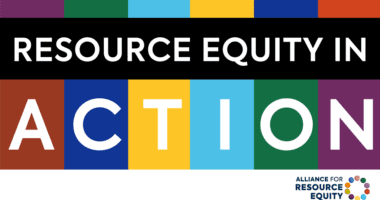A School Community That Engages Together, Stays Together
As every summer fades, the anticipation of a fresh academic year rises for educators, students, and their families across the country. In certain states in the south, the school bells have already rung, marking new beginnings. As a parent, this period evokes a myriad of feelings. There is the poignant moment of watching my children head back to their classrooms, coupled with the joy of evening conversations centering around, “How was school today?”
Still, I can’t help but think about the lingering effects the COVID-19 pandemic is still having on many students as they transition back to school this year. As the father of now seventh and fourth grade students, I know firsthand how much our youngest learners suffered social, emotional, and academic setbacks. The pandemic’s disruption to teaching and learning has created a uniquely challenging time for early elementary students and their teachers. For example, kindergarten enrollment was unusually low across the U.S. during the COVID-19 crisis, with its decline accounting for 30% of the total reduction of public-school enrollment during the pandemic across 33 states. At the same time, Black and Latino families of young children, across income-levels, have faced more material hardships than their White counterparts during the pandemic.
As parents prepare for the 2023-24 school year, many of whom are entering the school system as a parent for the first time, it is important that district and school leaders continue to work alongside families to address students’ unfinished learning caused by the COVID-19 pandemic and create the necessary conditions to foster a safe and welcoming learning environment for all who walk through their doors.
Family engagement can serve as a powerful tool that school leaders can use to give children and families a strong start.
Family engagement is associated with positive academic and social outcomes for students. When school staff effectively engage families, they are more aware of the needs and strengths of students and their families, and can provide them with more appropriate social, emotional, and academic supports.
To identify opportunities to better support young learners and their families, Ed Trust conducted a nationally representative survey of 900 parents of early elementary students and teachers to gather data and insights on the challenges, concerns, and needs of families and educators.
Here are just some of the topline findings:
There is room for improvement in how well schools make learning culturally sustaining.
- 23% of Black and Latino parents reported that their child’s school does not regularly incorporate exploring cultural diversity into school activities.
- One-third of Latino parents (33%) reported that their child’s school does not regularly connect students’ cultures and customs to what they are learning in the classroom.
Services and information that schools could provide to strengthen student success are not sufficiently available to families.
- Opportunities such as parent information hotlines in multiple languages, data nights, and resources and training for at-home academic support, were available to less than a quarter of teachers and parents and were attended by fewer than 10% of parents.
- Fewer than half of parents (43%) and teachers (45%) reported that their schools provide information to families on a clear plan to ensure students remain on track for their grade level.
- Fewer than half of parents (39%) and teachers (48%) noted that information was available on how to access extra academic support for students.
- Just over half of parents (55%) were aware of information available to them on whether their student meets grade-level expectations.
There are several missed opportunities for family engagement at school events, and too many schools are not yet meeting the lowest bar for family engagement.
- Only 67% of parents were aware of the opportunity for parent-teacher conferences at their child’s school, and 15% percent of teachers indicated that their schools do not provide parent-teacher conferences.
- 15% of parents — and even more Black parents (20%) — reported that they did not receive regular updates about their children’s academic progress.
- Nearly one-quarter (24%) of all parents, 30% of Black parents, and 37% of Asian American parents said the school didn’t communicate about how their child is doing socially and emotionally.
- 20% of parents reported that they did not get enough of a say in decisions about their child’s needs at school.
- 20% of parents reported that there were not many opportunities to engage with their child’s school, and 15% noted that the school does not actively communicate opportunities for engagement.
- 59% of parents reported that their child’s school had increased the number of virtual engagement opportunities due to COVID-19, despite parents wanting most virtual activities to continue.
- Parents cited several barriers to engaging with their children’s schools, such as scheduling conflicts (67%), child care needs (54%), not knowing how to get involved (51%), and feeling unwelcomed by other parents (48%).
5 Questions to Ask School Leaders About Family Engagement
Parents and educators are eager to participate and engage with their school community, which is why school leaders must actively engage with families in meaningful ways, fostering two-way communication and collaboration. By embracing equitable family engagement practices, schools and families can work toward ensuring every child receives the education they deserve. As you begin the new school year, consider asking your school leaders:
- What is your plan for engaging families this year?
- What is your plan for minimizing families’ barriers to engagement?
- What is your plan for communicating regularly with families about their children’s academic, social, and emotional progress?
- What resources (including remaining ESSER funds) do you have to support family engagement activities?
- How will you ensure that the school is welcoming and inclusive of different backgrounds and cultures, and how will you get honest feedback about how the school is doing?
For family engagement to be truly effective and equitable, it must address systemic challenges in education, including racism, ableism, and cultural and linguistic bias. From our families of English learners who often experience a lack of home language access; to Black parents, like me, who at times face racial bias when participating in school councils and organizing convenings; to our families of students with disabilities who must ensure services are provided; to families of LGBTQ+ students, who at this moment, are targeted by heinous legislation being introduced and passed. This year, and every year, how school communities choose to engage with families is crucial to the academic and social-emotional success of students. It takes a village, and this school year, I look forward to working hand in hand with my children’s village of teachers, principals, and school staff to ensure a strong start to the school year.





